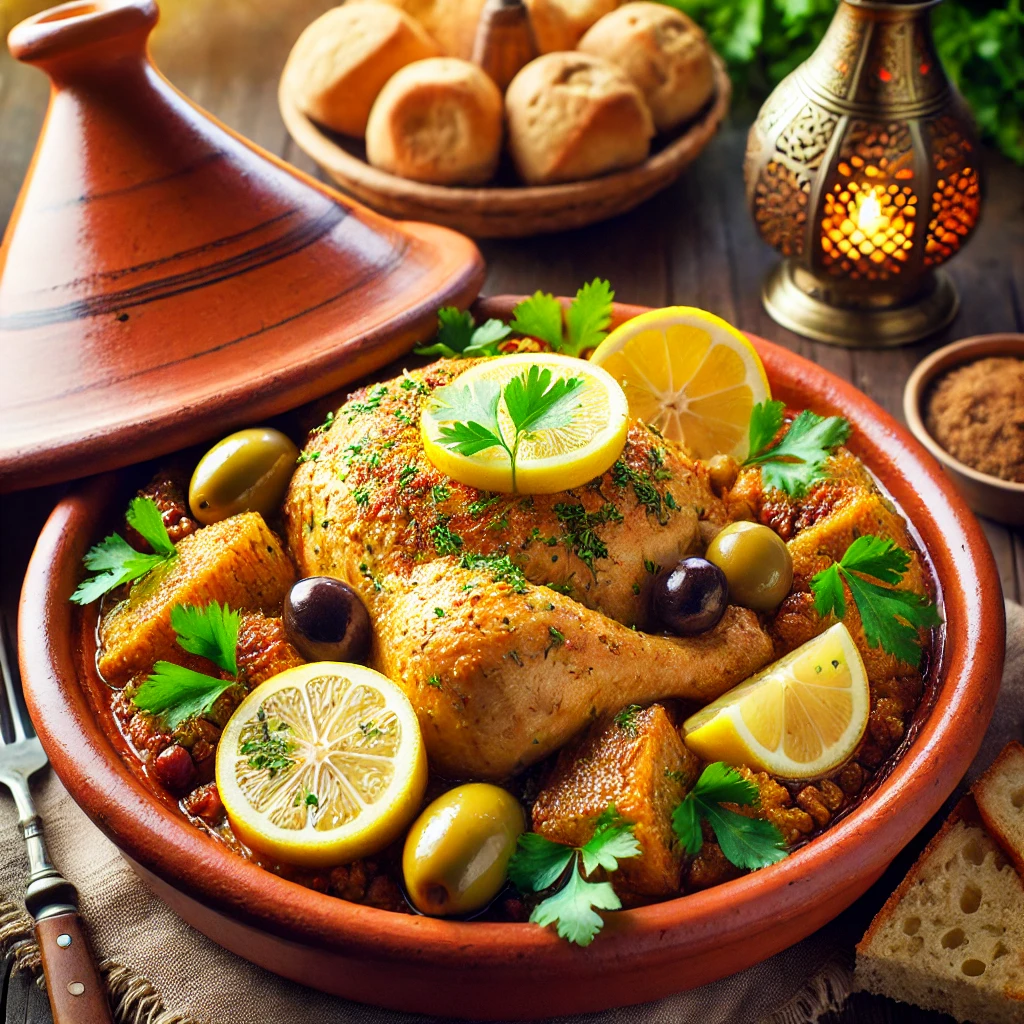
Introduction
RImagine the fragrant aroma of slow-cooked spices like saffron, cumin, and ginger wafting through your kitchen, mingling with the rich essence of tender Moroccan Tagine meat or vegetables. This is the magic of a traditional Moroccan Tagine, which has captured food lovers’ hearts and taste buds worldwide. Whether it’s a classic Chicken Tagine or a vegetable version, the tagine represents more than just a dish; it’s an experience, a reflection of Morocco’s vibrant culture, and a culinary journey to the streets of Marrakech.
In this article, I’ll walk you through the steps to create an authentic Moroccan Tagine at home. Whether you’re new to Moroccan cuisine or a seasoned cook looking for a new recipe to master, this guide will provide everything you need to create a flavorful tagine right in your kitchen.
Recipe Name: Traditional Moroccan Tagine
Description: This rich and aromatic Moroccan dish is slow-cooked with spices such as saffron, cumin, and ginge. It’s often served with tender meats or vegetables, creating a flavorful and savory experience
- Prep Time: 15 minutes
- Cook Time: 2 hours
- Total Time: 2 hours 15 minutes
- Servings: 4 servings
- Calories: 350 kcal (approx.)
Ingredients:
- 1 ½ lbs of lamb or chicken (or vegetables for a vegetarian option)
- 2 tbsp olive oil
- 1 onion, finely chopped
- 3 garlic cloves, minced
- 1 tsp ground cumin
- 1 tsp ground ginger
- 1 tsp ground cinnamon
- ½ tsp ground turmeric
- A pinch of saffron threads (optional but recommended)
- 2 preserved lemons, quartered
- 1 cup green olives
- 1 ½ cups chicken or vegetable broth
- 2 tbsp fresh cilantro, chopped
- 2 tbsp fresh parsley, chopped
- Salt and pepper to taste
Instructions:
- Prepare the Tagine Base: Heat olive oil in a traditional Moroccan tagine pot or a heavy-bottomed Dutch oven over medium heat. Add the onions and garlic, sautéing until softened.
- Add Spices: Stir in cumin, ginger, cinnamon, turmeric, and saffron. Let the spices toast for about a minute until they release their aroma.
- Brown the Meat or Vegetables: Add the lamb, chicken, or vegetables, and cook until browned on all sides.
- Add Liquids and Preserved Lemons: Pour in the broth and add preserved lemons and olives. Stir well to combine.
- Simmer Slowly: Reduce the heat to low, cover, and let the tagine simmer for 1 ½ to 2 hours. Stir occasionally, ensuring the flavors meld together and the meat or vegetables become tender.
- Finish with Fresh Herbs: Once cooked, garnish with cilantro and parsley. Taste and adjust seasoning if necessary.
- Serve: Serve the tagine hot, paired with couscous or flatbread.
Notes:
- For a vegetarian option, replace the meat with a hearty combination of vegetables, such as carrots, zucchini, and sweet potatoes.
- Adjust the spices to your taste—Moroccan food is all about bold, aromatic flavors.
Nutrition Information: Approx. 350 calories per serving, based on a chicken tagine.
Why You’ll Love This Recipe
- Slow-Cooked Flavor: The secret to a flavorful Moroccan tagine is its slow-cooking method. This method allows the spices to develop fully and the ingredients to become incredibly tender.
- Healthy and Nutritious: Tagines are often filled with lean meats, vegetables, and heart-healthy olive oil, making them a wholesome meal choice.
- Customizable: You can easily swap out ingredients or adjust spices to suit your preferences, whether you’re cooking for a family dinner or an exotic dinner party.
- Exotic Yet Accessible: While the ingredients might sound Exotic but Easy, most can be easily found in local grocery stores, and the preparation is simple for home cooks.
- One-Pot Meal: Cook everything in one pot, making for easy cleanup and a satisfying, hearty dish.
Key Ingredients and Substitutions
To make a traditional Moroccan tagine, a few key ingredients stand out:
- Preserved Lemons: These add a distinct tangy, slightly fermented flavor. If you can’t find preserved lemons, use fresh lemon zest and juice for a similar brightness.
- Saffron: Saffron is an expensive spice but provides a unique earthy flavor. If saffron is unavailable, turmeric can be a better, more affordable color substitute.
- Cumin and Ginger are essential in Moroccan cuisine. They create a warm, aromatic base. Ground coriander can be used as a substitute if needed.
- Olives: Green olives are typically used, adding a briny, savory element to the dish. If you don’t have olives on hand, capers can provide a similar salty punch.
How to Make a Traditional Moroccan Tagine (Step-by-Step)
- Sauté the Onions and Garlic:
Heat the olive oil in your tagine pot or Dutch oven. Add finely chopped onions and minced garlic. Let them sauté gently until soft and translucent. This step lays the foundation for the dish’s flavor - Add the Aromatic Spices:
Sprinkle in your spices—cumin, ginger, cinnamon, turmeric, and saffron. These spices are the soul of Moroccan cooking. Toast them for a minute to release their oils and enhance their aromas. - Brown the Meat (or Vegetables):
Add your chosen protein—lamb, chicken, or a mix of hearty vegetables for a vegetarian version. Brown the meat on all sides to lock in moisture and flavor. This step ensures your dish has deep, rich flavors. - Add the Broth, Lemons, and Olives:
After the meat has browned, add the broth. Add the quartered preserved lemons and olives. Mix all the ingredients together and bring the dish to a gentle simmer. - Slow-Cook the Tagine:
Lower the heat to a gentle simmer and place the lid on the pot. Let the tagine cook slowly for at least 1 ½ to 2 hours. This slow cooking is the secret to tender, melt-in-your-mouth meat and deeply infused flavors. - Garnish with Fresh Herbs:
Just before serving, stir in freshly chopped cilantro and parsley. These herbs brighten the dish and add a fresh, herbal note to balance the rich spices.
Expert Tips for Success
- Low and Slow: The key to a flavorful tagine is simmering it over low heat. This allows the flavors to develop and ensures the meat becomes tender without drying out.
- Use Quality Ingredients: Fresh spices and high-quality olive oil will significantly improve the taste of your tagine. Moroccan cuisine is all about the quality of the ingredients.
- Don’t Rush the Spices: Toast your spices before adding the broth. This simple step intensifies their flavor and elevates the dish.
- If you’re preparing a larger batch, cook in smaller portions to prevent overcrowding. Overcrowding the pot can lead to uneven cooking and a loss of flavor.
Variations and Customizations
The beauty of Moroccan tagine is that it’s adaptable to your tastes:
- Vegetarian Tagine: Swap the meat for hearty vegetables like carrots, zucchini, and sweet potatoes. Add chickpeas for extra protein and texture.
- Spicy Tagine: If you prefer a bit of heat, add a pinch of cayenne pepper or a chopped fresh chili for a spicier kick.
- Seafood Tagine: For a twist, try making a seafood tagine with shrimp or fish. To prevent seafood overcooking, the cooking time will be shorter, around 30-45 minutes.
- Gluten-Free Option: If you’re serving with couscous, you can make the meal gluten-free by switching to a gluten-free grain like quinoa or rice.
Storage and Reheating Instructions
Tagines taste even better the next day, making them perfect for leftovers.
- Storage: Keep any leftovers in a sealed container in the fridge for up to 3 days
- Freezing: The tagine can be frozen for up to 3 months. Make sure to cool it completely before freezing.
- Reheating: To reheat, gently warm the tagine on the stovetop over low heat. If it has thickened, add a splash of broth or water to loosen it.
Serving Suggestions
Moroccan tagine is a complete meal on its own but pairs beautifully with side dishes like:
- Couscous: On the traditional side, couscous soaks up the flavorful sauce from the tagine. Add a handful of raisins and slivered almonds to the couscous for extra flavor.
- Flatbread: Moroccan flatbread, known as khobz, is ideal for scooping up the sauce.
- Mint Tea: A glass of refreshing Moroccan mint tea complements the rich, savory flavors of the tagine.
Frequently Asked Questions (FAQs)
What is the secret to making a flavorful Moroccan tagine?
The secret to a flavorful Moroccan tagine is slow cooking. Allowing the dish to simmer gently ensures the spices meld together and the meat or vegetables become tender. Additionally, fresh spices like saffron, cumin, and ginger and quality ingredients like olive oil, garlic, and preserved lemons are crucial to achieving the authentic taste.
Can I make a tagine without a tagine pot?
Yes! While a traditional tagine pot is ideal, you can use a heavy-bottomed Dutch oven or a slow
cooker with great results.
Is tagine healthy?
Yes, tagines are generally very healthy. They are packed with lean meats, vegetables, and nutrient-rich spices, making them a balanced, wholesome meal.
Related Recipes
If you loved this traditional Moroccan tagine, you might also enjoy:
- Chicken Tagine with Apricots: A slightly sweeter version of tagine that pairs perfectly with couscous.
- Vegetarian Moroccan Couscous: A light and fluffy dish filled with roasted vegetables and aromatic spices.
- Lamb Kofta: Grilled ground lamb seasoned with Moroccan spices, served with a yogurt dip.
Conclusion
Creating a traditional Moroccan tagine at home is easier than you might think, and the results are well worth the time and effort. With its rich blend of spices and slow-cooked goodness, this dish will surely become a favorite in your recipe rotation. Try it for your next dinner party or a comforting family meal, and experience the flavors of Morocco in your own kitchen.
For more Moroccan recipes, check out these [link ] and discover other traditional dishes like couscous, harira, and more.
